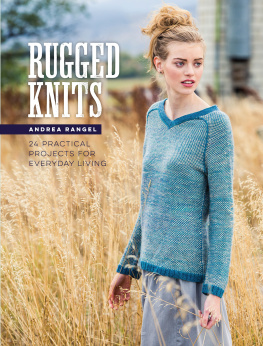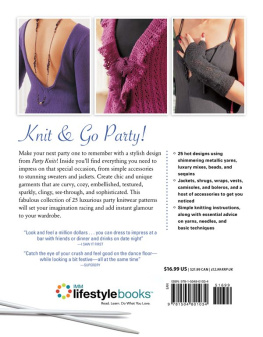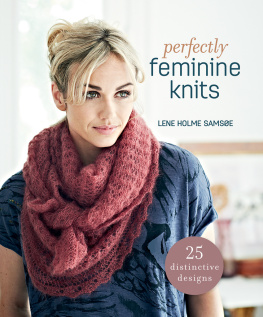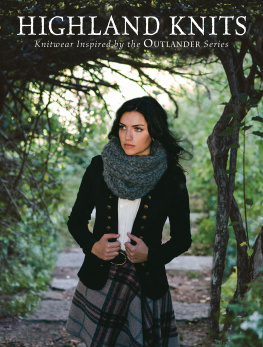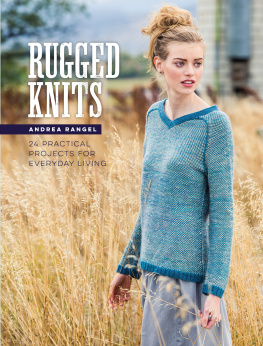Light &
Layered
KNITS
19 sophisticated designs
for every season
Vicki Square

Acknowledgments
For Justine, the embodiment of class.
I am grateful to Interweave for being my long-time partner in creativity. I have much to be thankful for, including the many who have contributed to this book.
I thank Allison Korleski for her visionary look into this books possibilities in the initial stages; Ann Budd for her attention to detail, her excellent editing skills, and her knowledgeable guidance; Eve Ng for her accurate technical editing and companionable way of working; Liz Quan for her complete understanding of my vision and her stylish art direction; Joe Hancock for his incredible artistry in photography, and his assistants, Jon Rose and Scott Wallace, for hospitality and fun; Kathy MacKay for lovely hair and makeup on models Ari, Christin, Eve, and Jessica, who brought my vision to life so beautifully; Pamela Chavez for providing just the right wardrobes; Julia Boyles for her graphic arts creativity in bringing a beautiful book to life; and Elisabeth Malzahn for expertly getting the word out. Finally, I thank Rebecca Campbell, whose constant encouragement, attention to schedule, and oversight kept me going with enthusiasm.
Honors go to my knitting family, who work tirelessly to help me achieve my goals. My knitters par excellence are Micky Shafer, Gina Kohler, Nancy Hewitt, Sally Thieszen, Karen Tadich, Jeanne Fangman, Joan Pickett, and Julie Richter. I could not do this without you, as you well know.
To all the yarn companies, I thank you for giving knitters everywhere magnificent yarns to choose from and for graciously providing some of them to bring my designs to life: Louet North America, Tahki Stacy Charles, South West Trading Company, Rowan/Westminster Fibers, Classic Elite Yarns, Plymouth Yarn Company, Cascade Yarns, Misti Alpaca, Blue Heron, and Skacels Austermann, Schulana, and Zitron. I now have new yarn favorites to add to my longstanding ones.
As always, heartfelt gratitude goes to my family for their unbroken stream of encouragment and for letting me bury my head in the sand, er, yarn, while life goes on without me for a while. My husband Johnny, our son Alex, and daughter and son-in-law Justine and Jeffreythank you for being my rudder in the sea of book writing.

Contents

Todays woman is a modern maven of multi-tasking. As a whole, we have become experts at fluidly moving from one pursuit to the next with nary a moment to recalibrate our focus. We are passionate about all the things we do, bringing our giftedness into the mix of work and play. We want our wardrobes to speak of that mettle, and to reflect our personal styles.
My inspiration for this collection was to gather garments that every knitter wants to wear any day, anywhere, and in any season. With that goal in mind, I have designed a number of lightweight tops that are functional on so many levels that youll return to them again and again to ante up to that perfect blend of feeling confident, comfortable, and chic. The garment designs are streamlined and figure flattering for enduring style, giving a healthy bolster to your valuable knitting time. Simple elegance defines each piece, whether it is designed for a close fit or loose drape.
Creative details promote a unique presentationcables, raised stitches, pleats, and peplums define shape. Lace, intarsia, Fair Isle, and slip-stitch patterns offer challenges in knitting technique. The color palette is at times vivid and bold or neutral and subtle, and can always be personalized. I have used traditional knitting techniques in unusual ways and in combinations to give your wardrobe artistic panache.
These projects include yarns of linen, silk, bamboo, rayon, cotton, soy, and natural fibers of the non-wool variety, along with some beautiful synthetic novelty exceptions. They provide a solid foundation for building a wardrobe light enough to wear year round, next to the skin or in layers, for a variety of looks and styles.
Layering is the contemporary way to personalize style and expand function for comfort in any situation. Layers accommodate a variety of climates, seasonal temperature changes, daily fluctuations between the hot (or cold) outdoors and the cool (or warm) indoors, and even our own unreliable internal thermostats.
Layering also allows us to transiton between the activities of any given dayperhaps from business casual at work, followed by a sporting event, and then to a restaurant. Clearly, one style will not serve all events equally, but with thoughtfully selected key wardrobe pieces, you can easily change one or two outer pieces or accessories and completely change the look to fit the situation at hand.
The lightweight sweaters in this collection can go seamlessly from one look to another, simply by changing a wardrobe basic, such as from a pencil skirt to dress pants to a pair of jeans. The idea behind this, of course, is that the fabulous sweater you just knitted is the piece that is constant!

Knitting is certainly a lifestyle, and those of us who partake in it enjoy hours, which grow into years, of joyous activity. But wearing your knitting is a lifestyle all its own. There is a wealth of garment types, from classic traditionals to one-of-a-kind artful statements that may outfit only a single look. I believe that there is room for all of these pursuits. I will, however, entreat you to view a portion of your knitting as a wardrobe builder, so that you will have a selection of knitted basics to elevate the aesthetic of all potential ensemble coordinates.
It Begins and Ends with Fit
We all tend to choose clothing that fits us best when deciding what to wear each day. And we all have examples of almost-but-not-quite garments that we never wear but refuse to get rid of. More often than not, a less-than-pleasing fit drives that garment back into the closet. Nothing ruins the success of a wardrobe faster than ill fit. With a multitude of accurate body measurements, knowledge of how to use your gauge, and a few tricks of the trade, you can achieve the right fit for you.
First, take accurate body measurements. At the very least, you need to know your bust/chest, waist, and hip circumferences, and the ideal lengths from hips to underarm and from underarm to shoulder. Also extremely helpful are the upper back width, arm length from the edge of the shoulder bone to the wrist bone when the arm is slightly bent, underarm to wrist bone with arm slightly bent, and underarm to the narrowest part of the waist. The more particular you are about the measurements, the better you can make adjustments to patterns for the best fit. One easy way to get the fit you like is to measure a favorite garment from your closet that fits perfectly. Take careful measurement and knit your own piece to the same dimensions.
Keep in mind that body measurements do not include easeits up to you to decide how much ease you want and to include it in the garment measurements. A close-fitting sweater is one that doesnt have much easeit hugs the body and reveals all the curves. Such garments may actually measure one or two inches (2.5 to 5 cm) smaller than the body circumference so that they stretch for a body-conscious fit. If youd rather have your garment hang a bit looser, add about 2" to 4" (5 to 10 cm) of ease to your body circumference. Add more ease if youd like a very loose, baggy fit.


